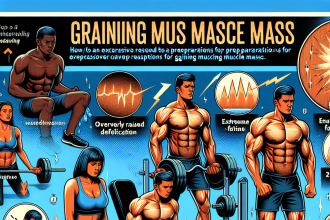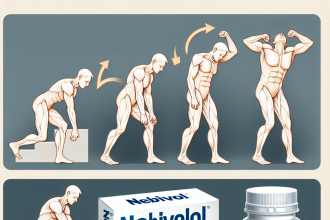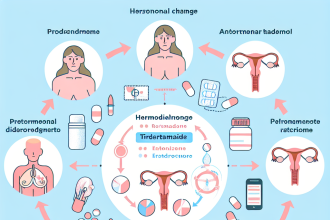-
Table of Contents
«Protect your joints, know the risks of Finasteride.»
Introduction
Finasteride es un medicamento comúnmente utilizado para tratar la pérdida de cabello en hombres, así como para tratar la hiperplasia prostática benigna (HPB). Sin embargo, algunos pacientes pueden experimentar efectos secundarios, incluida la inflamación articular. En este artículo, exploraremos si el Finasteride puede causar inflamación articular y cómo se puede manejar esta posible reacción adversa.
Understanding the Link Between Finasteride and Joint Inflammation
Finasteride is a medication commonly used to treat male pattern baldness and enlarged prostate. While it has been proven to be effective in these conditions, there have been concerns about its potential side effects. One of the reported side effects of finasteride is joint inflammation, also known as arthritis. This has raised questions about the safety of using this medication and its potential impact on joint health.
To understand the link between finasteride and joint inflammation, it is important to first understand how finasteride works. Finasteride works by inhibiting the conversion of testosterone to dihydrotestosterone (DHT), a hormone that is responsible for male pattern baldness and prostate enlargement. By reducing DHT levels, finasteride can slow down hair loss and shrink an enlarged prostate. However, DHT also plays a role in maintaining healthy joints, and this is where the potential link between finasteride and joint inflammation comes into play.
Studies have shown that DHT has anti-inflammatory properties and helps to protect joints from damage. By inhibiting DHT production, finasteride may be disrupting this protective mechanism and leaving joints vulnerable to inflammation. This is further supported by the fact that men who have naturally low levels of DHT are more likely to develop joint problems. Therefore, it is possible that finasteride may be contributing to joint inflammation in some individuals.
In addition to its effect on DHT levels, finasteride may also indirectly contribute to joint inflammation through its impact on testosterone. Testosterone is an important hormone for maintaining muscle mass and bone density, both of which are crucial for joint health. Finasteride has been shown to decrease testosterone levels, which could lead to muscle and bone loss, ultimately increasing the risk of joint problems.
Furthermore, finasteride has been linked to a condition called hypogonadism, which is characterized by low testosterone levels. Hypogonadism has been associated with joint pain and inflammation, further strengthening the potential link between finasteride and joint problems. It is important to note that not all men who take finasteride will experience joint inflammation, as individual factors such as genetics and lifestyle also play a role.
So, what can be done to mitigate the potential risk of joint inflammation while taking finasteride? The first step is to consult with a healthcare professional before starting the medication. They can assess your individual risk factors and determine if finasteride is the right choice for you. If you are already taking finasteride and experiencing joint pain or inflammation, it is important to discuss this with your doctor. They may recommend alternative treatments or adjust your dosage to minimize the side effects.
In addition to medical interventions, there are also lifestyle changes that can help to support joint health while taking finasteride. Regular exercise, particularly weight-bearing exercises, can help to maintain muscle mass and bone density. A healthy diet rich in anti-inflammatory foods, such as fruits, vegetables, and omega-3 fatty acids, can also help to reduce joint inflammation. It is also important to avoid smoking and excessive alcohol consumption, as these habits can worsen joint problems.
In conclusion, while finasteride has been proven to be effective in treating male pattern baldness and enlarged prostate, it is important to be aware of its potential side effects. Joint inflammation is one of the reported side effects of finasteride, and it is believed to be linked to its impact on DHT and testosterone levels. By consulting with a healthcare professional and making lifestyle changes, the risk of joint inflammation while taking finasteride can be minimized. It is important to weigh the potential benefits and risks of any medication, and to always prioritize your overall health and well-being.
Managing Joint Pain While Taking Finasteride: Tips and Strategies
Joint pain is a common ailment that affects millions of people worldwide. It can be caused by a variety of factors, including injury, arthritis, and certain medications. One medication that has been linked to joint pain is Finasteride, a drug commonly used to treat enlarged prostate and male pattern baldness. While Finasteride has been proven to be effective in treating these conditions, some users have reported experiencing joint pain while taking the medication. This has raised the question: can Finasteride cause joint inflammation?
Before delving into the potential link between Finasteride and joint pain, it is important to understand how the medication works. Finasteride works by inhibiting the production of dihydrotestosterone (DHT), a hormone that contributes to the enlargement of the prostate and hair loss in men. By reducing DHT levels, Finasteride helps to shrink the prostate and promote hair growth. However, DHT also plays a role in maintaining healthy joints, which is why some users may experience joint pain while taking Finasteride.
Several studies have been conducted to investigate the potential link between Finasteride and joint pain. One study published in the Journal of Clinical Endocrinology and Metabolism found that men who took Finasteride for enlarged prostate had a higher risk of developing joint pain compared to those who did not take the medication. Another study published in the Journal of the American Academy of Dermatology found that men who took Finasteride for male pattern baldness experienced joint pain and stiffness, with some cases being severe enough to discontinue the medication.
While these studies suggest a potential link between Finasteride and joint pain, it is important to note that correlation does not necessarily equal causation. There could be other factors at play, such as age, pre-existing joint conditions, or lifestyle habits. Additionally, these studies were conducted on a relatively small sample size and may not be representative of the entire population.
So, what can you do if you are experiencing joint pain while taking Finasteride? The first step is to consult with your doctor. They can evaluate your symptoms and determine if they are related to the medication or if there is another underlying cause. If it is determined that Finasteride is the culprit, your doctor may recommend switching to a different medication or adjusting your dosage.
In addition to consulting with your doctor, there are also some tips and strategies you can implement to manage joint pain while taking Finasteride. First and foremost, it is important to maintain a healthy lifestyle. This includes regular exercise, a balanced diet, and getting enough rest. Exercise can help strengthen your muscles and joints, while a healthy diet can provide the necessary nutrients to support joint health. Getting enough rest is also crucial as it allows your body to repair and recover.
Another strategy to manage joint pain is to incorporate low-impact exercises into your routine. Activities such as swimming, cycling, and yoga can help improve joint mobility and reduce pain. It is important to avoid high-impact exercises that can put strain on your joints, such as running or weightlifting.
In addition to exercise, you may also find relief by using heat or ice therapy. Applying a heating pad or taking a warm bath can help relax your muscles and ease joint pain. On the other hand, applying an ice pack can help reduce inflammation and numb the pain.
Lastly, consider incorporating supplements into your daily routine. Glucosamine and chondroitin are two supplements that have been shown to improve joint health and reduce pain. However, it is important to consult with your doctor before starting any new supplements, as they may interact with other medications you are taking.
In conclusion, while there is some evidence to suggest a potential link between Finasteride and joint pain, more research is needed to establish a definitive connection. If you are experiencing joint pain while taking Finasteride, it is important to consult with your doctor and implement strategies to manage the pain. By maintaining a healthy lifestyle, incorporating low-impact exercises, and using heat or ice therapy, you can effectively manage joint pain while taking Finasteride.
Exploring Alternative Treatment Options for Hair Loss: Is Finasteride Worth the Risk?
Hair loss is a common issue that affects millions of people worldwide. It can be caused by a variety of factors, including genetics, hormonal changes, and certain medical conditions. For many individuals, hair loss can have a significant impact on their self-esteem and confidence. As a result, there is a high demand for effective treatment options.
One of the most popular treatments for hair loss is Finasteride, also known by its brand name Propecia. This medication works by blocking the conversion of testosterone into dihydrotestosterone (DHT), a hormone that is responsible for shrinking hair follicles and causing hair loss. While Finasteride has been proven to be effective in treating hair loss, there have been concerns about its potential side effects, including joint inflammation.
Joint inflammation, also known as arthritis, is a condition that causes pain, stiffness, and swelling in the joints. It can be caused by a variety of factors, including age, injury, and certain medical conditions. Many people who are considering taking Finasteride may wonder if it can cause joint inflammation and if it is worth the risk.
The short answer is yes, Finasteride can cause joint inflammation in some individuals. According to a study published in the Journal of the American Academy of Dermatology, 1.3% of men who took Finasteride experienced joint pain and inflammation. While this may seem like a small percentage, it is still a potential side effect that should not be ignored.
So, why does Finasteride cause joint inflammation in some individuals? The exact mechanism is not fully understood, but it is believed that the medication may interfere with the body’s production of certain enzymes that are involved in joint health. This can lead to an inflammatory response in the joints, causing pain and discomfort.
It is important to note that not everyone who takes Finasteride will experience joint inflammation. In fact, many individuals take the medication without any side effects. However, it is essential to be aware of the potential risks and to monitor your body for any changes or symptoms while taking Finasteride.
If you do experience joint inflammation while taking Finasteride, there are some steps you can take to alleviate the symptoms. First and foremost, it is crucial to consult with your doctor. They may recommend reducing the dosage or switching to a different medication. Additionally, incorporating anti-inflammatory foods into your diet, such as fatty fish, leafy greens, and berries, may help reduce joint inflammation.
It is also essential to maintain a healthy lifestyle while taking Finasteride. Regular exercise can help improve joint health and reduce inflammation. It is also important to avoid smoking and excessive alcohol consumption, as these habits can worsen joint inflammation.
While Finasteride may be an effective treatment for hair loss, it is not the only option available. There are alternative treatments that may be worth considering, especially for those who are concerned about the potential side effects of Finasteride.
One alternative treatment for hair loss is minoxidil, also known as Rogaine. This medication works by increasing blood flow to the scalp, promoting hair growth. Unlike Finasteride, minoxidil is applied topically and does not have the potential for systemic side effects.
Another option is low-level laser therapy (LLLT), which uses red light to stimulate hair growth. LLLT has been shown to be effective in treating hair loss, and it does not have any known side effects.
In conclusion, while Finasteride may be an effective treatment for hair loss, it is essential to be aware of the potential side effects, including joint inflammation. If you experience any symptoms while taking the medication, it is crucial to consult with your doctor. Additionally, exploring alternative treatment options may be worth considering for those who are concerned about the potential risks of Finasteride. Ultimately, the decision to take Finasteride should be made after careful consideration and consultation with a healthcare professional.
Q&A
1. ¿Puede Finasteride causar inflamación articular?
Sí, en algunos casos raros, Finasteride puede causar inflamación en las articulaciones como efecto secundario. Si experimentas este síntoma, es importante que consultes a tu médico para evaluar si debes continuar con el medicamento o cambiar a otro tratamiento.
2. ¿Cómo puedo saber si la inflamación articular que estoy experimentando es causada por Finasteride?
Si estás tomando Finasteride y comienzas a experimentar inflamación en las articulaciones, es importante que consultes a tu médico. Ellos podrán realizar un examen físico y revisar tu historial médico para determinar si la inflamación está relacionada con el medicamento o si hay otra causa subyacente.
3. ¿Qué debo hacer si estoy experimentando inflamación articular mientras tomo Finasteride?
Si estás experimentando inflamación en las articulaciones mientras tomas Finasteride, es importante que consultes a tu médico. Ellos podrán evaluar tu situación y determinar si debes continuar con el medicamento o cambiar a otro tratamiento. También pueden recomendarte medidas para aliviar la inflamación, como descansar la articulación afectada y aplicar hielo. No debes dejar de tomar Finasteride sin consultar a tu médico primero.




